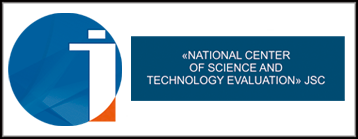Research into the possibility of air separation of cake at the Pavlodar aluminum smelter
DOI:
https://doi.org/10.31643/2026/6445.34Keywords:
air separation, extraction of valuable components, alumina, sintering process, sinter.Abstract
Air separation can play a key role in the sintering process of the charge material in the alumina production at the Pavlodar Aluminum Plant. During sintering, sinter dust is formed, which must be effectively separated from the bulk material, since its fine fraction is a source of formation of a solid phase carried away with the solution, which increases the number of secondary losses of valuable components. The use of air separation will solve this problem, providing a high degree of separation of the sinter product into coarse and fine fractions, thereby intensifying the further process of hydrochemical processing of the sinter from the sintering furnaces. The main goal of these studies was to reduce the loss of valuable components from the sinter, namely aluminum oxides and alkali, which are carried away with the solid phase of the tubular apparatus effluent. This paper considers the preliminary classification of sinter dust in air separators and its separate leaching. Extensive (pilot) laboratory tests determined the separation boundary of sinter classes (– 0.25 mm), which allows increasing alumina extraction by ~ 2% and suggests a reduction in the number of operating furnace lines by 0.26 units by reducing ballast flows, and the optimal indicator of air separation efficiency was determined to be ~ up to 97%. The results demonstrate the importance of air separation in ensuring the quality of the sinter product and improving the efficiency of alumina production technology as a whole.
Downloads
References
Michael Betz, Marco Gleiss, Hermann Nirschl. Effects of Flow Baffles on Flow Profile, Pressure Drop and Classification Performance in Classifiers. A review. 2021; 9(7):1213. https://doi.org/10.3390/pr9071213
Gal'perin VI. Air classification of bulk materials materials. Part 1. Basic definitions and technological indicators. (Еlectronic resource). 2005. https://www.elibrary.ru/download/elibrary_15201561_35666482.pdf
Xueshuai Zhu, Chenyu Zhang, Ping Feng, Xizu Yang, Xiaojuan Yang. A novel pulsated pneumatic separation with variable-diameter structure and its application in the recycling spent lithium-ion batteries. A review. 2021; 131:20-30. https://doi.org/10.1016/j.wasman.2021.05.027
Лун Хуан, Рунью Лю, Цюхуа Мяо, Жуйпин Цзоу, Хайшэнь Цзян, Чэньлун Дуань, Шибо Куанг. Dynamic characteristics of the flow field of the disrupted structures of the air classifier and application for effective separation of fly ash. A review. 2024; 12(6):114706. https://doi.org/10.1016/j.jece.2024.114706
Arjun Kumar Pukkella, Jan J. Cilliers, Kathryn Hadler. A comprehensive review and recent advances in dry mineral classification. 2023; 201:108208. https://doi.org/10.1016/j.mineng.2023.108208
Ibragimov AT, Budon S V. Razvitiye tekhnologii proizvodstva glinozema iz boksitov Kazakhstana [Development of technology for the production of alumina from bauxite in Kazakhstan]. Pavlodar: House of Printing LLP. 2010, 215. (in Russ).
Pat. 10773 KZ. Sposob gidrokhimicheskoy pererabotki tverdogo veshchestva i reaktor dlya ego osushchestvleniya [Method for hydrochemical processing of solid matter and a reactor for its implementation]. Tverdokhlebov SA, Glukhov IA, Podnebesnyy GP, Synkova LN. 15.10.2001. (in Russ).
Pat. 1667. Sposob gidrokhimicheskoy pererabotki speak [Method of hydrochemical processing of sinter]. Pechenkin MN, Yanin SV, Sabitov AR, Rakhiyanov MA, Tverdokhlebov SA, Ponezha AI. 15.09.2016. (in Russ).
Ponomarev VB. Pererabotka metallurgicheskih shlakov metodom pnevmaticheskoj separacii. [Processing of metallurgical slags by pneumatic separation]. Zhurnal stal = Intermet Inzhiniring. 2015; 2:82-83. (In Rus.). https://www.elibrary.ru/download/elibrary_24219851_45466287.pdf
Air sorting. https://studref.com/362206/tehnika/vozdushnaya_sortirovka#aftercont (Еlectronic resource). 2024 (date of access: 30.10.2024)
Installations for air separation of materials. https://forpsk.ru/index.php/stati/oborudovanie/232-ustanovki-dlya- vozdushnoj-separatsii-materialov. 2012 (Еlectronic resource) (date of access: 14.02.2025)
Smyshlyaev GH. Vozdushnaya klassifikaciya v tehnologii pererabotki poleznyh iskopaemyh [Aerial classification in technology recycling useful fossils]. Moskva: Izdatel'stvo nedra. 1969, 108. (in Russ).
Ponomarev VB. Raschet i proektirovanie oborudovaniya dlya vozdushnoj separacii sypuchih materialov [Сalculation and design of equipment for air separation of bulk materials]. Uchebnoe posobie. Ekaterinburg: Izdatel'stvo Ural'skogo universiteta. 2017, 90. (in Russ).
Arjun Kumar Pukkella, Jan Cilliers, Kathryn Hadler. Design of parabolic conic gas cyclones for coarse particle classification: A CFD study with Response Surface Methodology. 2024; 433:119217. https://doi.org/10.1016/j.powtec.2023.119217
Mohammad Barimani, Sheldon Green, Steven Rogak. Particulate concentration distribution in centrifugal air classifiers. A review. 2018; 126:44-51. https://doi.org/10.1016/j.mineng.2018.06.007
Qi Chen, Junhao Hu, Haiping Yang, Daqian Wang, Huihui Liu, Xianhua Wang, Hanping Chen. Experiment and simulation of the pneumatic classification and drying of coking coal in a fluidized bed dryer. A review. 2020; 214:115364. https://doi.org/10.1016/j.ces.2019.115364
Ashkan Bagherzadeh, Masoud Darbandi, Mohammad Bagher Barezban. Numerical simulation of particle separation in a two-phase flow passing through a vortex-based air classifier using Eulerian–Lagrangian DDPM approach. A review. 2024; 445:120036. https://doi.org/10.1016/j.powtec.2024.120036
Multi-product cascade-gravity classifiers. URL: https://www.lamel777.ru/ikk_i_pereabotka_otsevov/kgk/ (Еlectronic resource) (date of access: 30.10.2024)
Classifiers. https://uralomega.ru/equipments/separators (Еlectronic resource) (date of access: 30.10.2024)
Dry enrichment - pneumatic separation complex SEPAIR. URL: https://gmexp.ru/equipment/type/grav/sepair.html (Еlectronic resource) (date of access: 30.10.2024)
Peter V Polyakov, Nataliya V Oleinikova, Vladimir A Makarov. Prakticheskiye rezul'taty i perspektivy sukhogo obogashcheniya nekonditsionnykh rud i tekhnogennykh otkhodov metodom pnevmoseparatsii. XII Kongress Tsvetnyye metally i mineraly [Practical results and perspectives for dry beneficiation of substandard ores and technogenic wastes by pneumatic separation method. XII Congress Non-ferrous metals and minerals], September 9-13; Krasnoyarsk, Russia. (Issue ХII), 2024, 96 -98. https://doi.org/10.12731/978-5-907608-43-6
Downloads
Published
How to Cite
Issue
Section
License
Copyright (c) 2025 G.K. Abikenova, S.A. Tverdokhlebov, D.D. Dauletov, I.S. Danchenko

This work is licensed under a Creative Commons Attribution 4.0 International License.


























